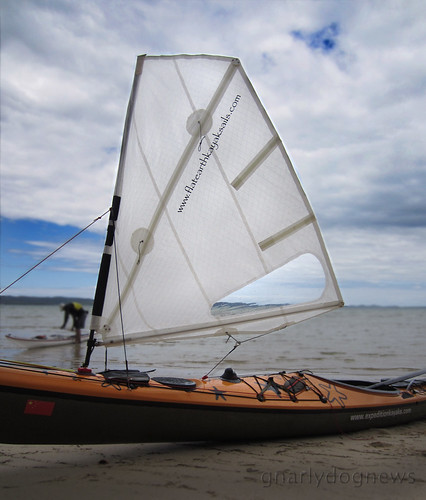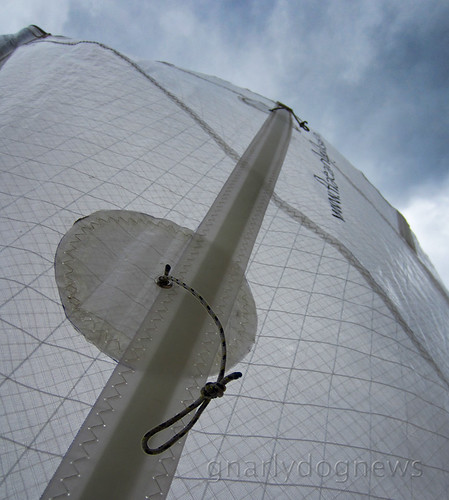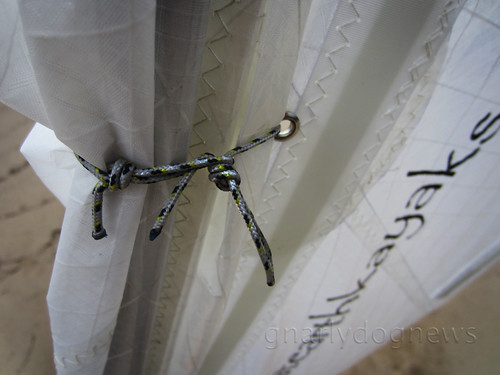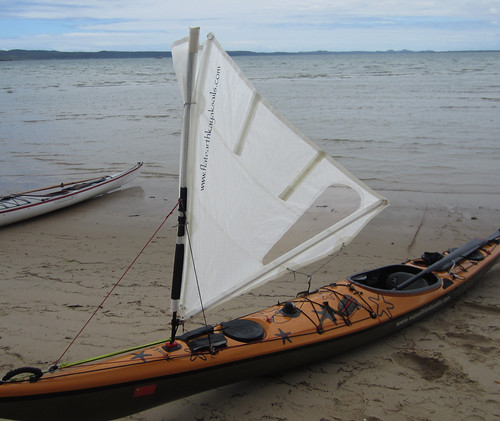I have been very satisfied with the design and quality of Mick's sails in the past and I now use them exclusively on all of my kayaks.
I believe the design is superior to the ones I designed and they are easier to use.
While Mick can supply a complete sail set (sail, mast, deck fittings and sheet) I use my own rig that is slightly different to his standard approach.
I was keen to try his high mounted sails with the stays below the boom for this new sail but I realized I would have to modify some deck anchors so I decide to simply slip the new sail on my existing mast and stays; there has been no modifications to the rigging.
The new sail uses Code Zero sail cloth: a very thin but very dimensionally stable material that has reinforcement filaments laminated into the surface.
The material does not stretch and does not wet out as much as conventional sail cloth keeping the sail light and maintaining its shape when dunked in the water.
I still remember the difference a wet or dry sail made when I used to windsurf: after a water start the sail seemed sluggish and slow to gradually become more taught as the sail would dry out. Once fully dry the fabric would shrink and the sail was “fast” again. I am not sure if the surface area of a kayak sail is affected as much as a windsurfing one but having a dry fabric seems an advantage to me.

FEKS Code ZERO 1 meter, fully deployed
The sail is shaped differently than my other two FEKS: the shape is fuller and closer to the mast that flattens out towards the rear. There are more panels sewn into this sail to create the efficient shape. Mick’s sails seem to be less susceptible to wind change directions and they don't need constant trimming to get the maximum power from them, if compared to my own designed sails. In other words they are more forgiving. What makes them even more user friendly is the shock absorption built into the main sheet. When the sail is hit by a gust of wind the bungee cord stretches and spills some of the wind to possibly prevent a capsize of the kayak.
My new sail is rather large: 1.0 m². For a sea kayak sail that large surface can become a handful in higher winds (let’s say above 20knots).
When on a kayak sailing outing on a few occasions I had to lower my sail and stow it away when the wind picked up beyond what I could comfortably handle in my kayak; the sail was just too big for the stiff breeze.
Mick has engineered a simple solution to reduce the sail area (reef) and make it still usable in higher winds.

reefing points with simple Dyneema loops
I have used a very thin Dyneema line to create simple loops that can tie around the mast and hold back a section of the sail . The reduced area (0.5 m²) is much more manageable when the wind really blows. Unfortunately I have not come up with a solution on how to reef the sail by myself when seated in the cockpit; I need somebody’s help to do so.

sail reefed to reduce the surface area
My first outing with the Code Zero consisted of a short trip to a small island and back across a tidal flow channel. Initially the breeze was very gentle (just a few knots) to suddenly change to a solid 10-15 knots with several higher gusts.
The sail performed very well in those breezes but I had no opportunity to try it in something more challenging to the point to have to reef it and observe its performance when the surface of the sail is reduced.

in this configuration the sail can be used in higher winds without overpowering
The Code ZERO sails will be available in a limited edition in early 2012.
.

What are the dimensions of the sail (hight of the sail and lenght of the boom etc..)?
ReplyDelete- jeremy
I don't know the dimensions off hand (my sail is a custom prototype and maybe different that a production one) but you are welocme to contact Mick at Flat Earth Sails and he will be very happy to discuss details with you.
Delete